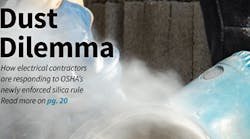Sometimes, it would be more accurate to call breaker maintenance "breaker breaking" because of the way it gets done. Common breaker maintenance mistakes include:
- Dimensional adjustments (e.g., contact wipe). Adjust per the manufacturer's recommendations, but only if they need to be adjusted.
- Bolted bus connections. Retightening these "just in case they are loose" weakens them. Instead, conduct conductivity measurements across the connections using an AC resistance meter (and infrared inspection prior to breaker maintenance) to identify which connections need corrections. Disassemble and clean, installing any new hardware (e.g., lockwashers) possible, and then tighten to the recommended torque.
- Lubrication. Use only the lubricant recommended by the manufacturer. If you mix incompatible greases, the resulting compound may be extremely abrasive. Always clean before lubricating, and apply only the recommended amount of lubricant.


